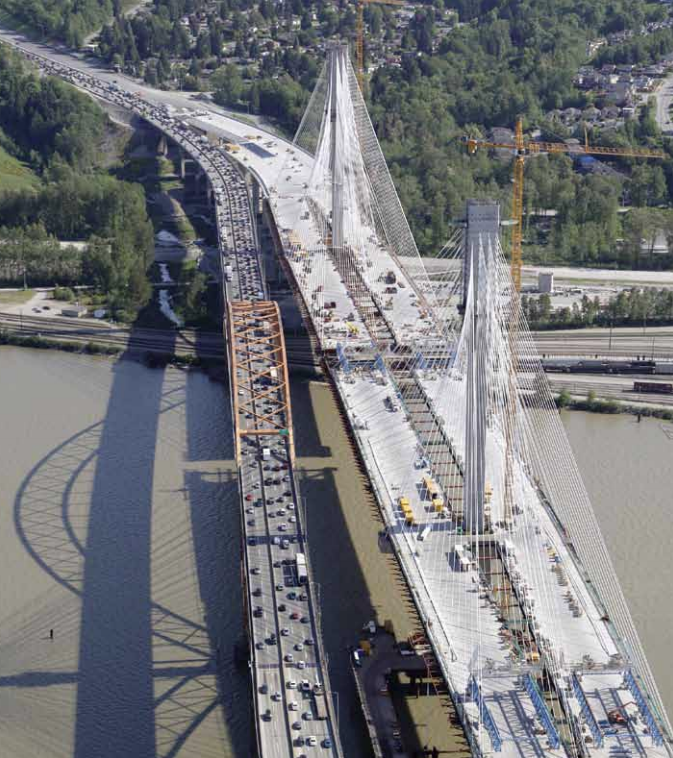Project News
Main Span Connected on Port Mann Bridge

The gap in the middle of the new Port Mann Bridge in Vancouver disappeared on June 16 when crews hoisted and placed the final closure girder, installed the floor beam and two rows of concrete panels, and poured the concrete, finally connecting the main span.
The 850-meter-long cable-stayed main span, one of the longest in the world, was constructed using the balanced cantilever method.
Cable-stayed bridge towers are typically constructed in the shape of an “H” or “A”, with the deck going through the middle of the “H” or “A” frames. Instead of the traditionally shaped towers, Port Mann Bridge has towers that are more “I” shaped.
 “This shape is unique because the cable stays and the deck extend along both sides of the single pylon,” says superintendent Paul Hopkins, who has been overseeing the deck erection on the north side of the bridge since April 2011.
“This shape is unique because the cable stays and the deck extend along both sides of the single pylon,” says superintendent Paul Hopkins, who has been overseeing the deck erection on the north side of the bridge since April 2011.
Engineers Brian Witte and Allan Brayley, who helped with the construction engineering, agree about the uniqueness.
“This was a unique project because the stays fan out from the top of the pylon over the bridge deck which created geometric challenges. Like the single-tower design, we not only had to balance the deck erection fore and aft, but we also had to balance side-to-side,” says Allan.
There are 144 cable stays that extend from each 535-foot-tall tower. Paul spent most of his spring working 12- to 14-hour days, six days a week overseeing the north end’s main span construction. Structural steel segments, preassembled in the nearby marine yard, were transported via barge to a spot directly under their permanent position. DEAL gantries anchored to a floor beam on the deck lifted these segments off of the barge and up into place.
“We hoisted the pre-assembled steel segments, installed the cable stays, placed the precast deck panels, filled the stitches with rebar and then poured the concrete,” says Paul of the cycle that was repeated for each main span segment.
The project actually utilized four different pieces of equipment to erect the superstructure. Crews working over the water used DEAL gantries, but the south side of the bridge is over land and railroad tracks, so that method wouldn’t work.
“We couldn’t get access to lift the pre-assembled steel segments, so we had to lift each of the components—the edge girders, floor beams and deck panels—separately with a crane and then truck them into place,” says Allan.
“I enjoyed this project because the uniqueness of the bridge required real, meaningful collaboration with our partners and designers,” notes Brian.
The main span is flanked by two approaches, connecting Coquitlam in the north and Surrey in the south. The south approach was completed earlier this year, and crews recently completed the north approach. Randy Bowman, general superintendent for the approach superstructure, said that the north and south approaches combined consisted of 1,158 segments weighing 80 tons each and erected by a 720-ton self-launching gantry.
The segmental erection for the approaches is approximately 90 percent complete for this phase, and in phase two the remaining 178 segments will be erected after the removal of the existing bridge.
Mechanical engineer Nathan Johnson, who worked on the north/south foundations for slightly more than two years before moving to the north side to do structures work, says “with the interchange work going on, soon we’ll have a large-scale traffic detour to get traffic on, across, and off the first phase of the main span.”
Crews at all areas of the project are working towards this major milestone. The bridge is slated to open to traffic in December.

